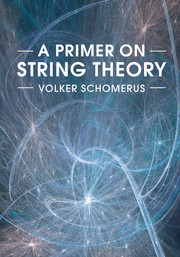Book contents
- Frontmatter
- Contents
- Preface
- 1 Historical Introduction and Overview
- Part I Strings in Flat Backgrounds
- Part II Strings in Curved Backgrounds
- 13 Introduction to Conformal Field Theory
- 14 Modular Invariants and Orbifolds
- 15 Closed Strings on the 3-Sphere
- 16 CALABI-YAU Spaces
- 17 CALABI-YAU Compactifications
- 18 String Dualities
- 19 Gauge/String Dualities
- 20 AdS/CFT Correspondence
- Bibliography
- Index
19 - Gauge/String Dualities
from Part II - Strings in Curved Backgrounds
Published online by Cambridge University Press: 05 July 2017
- Frontmatter
- Contents
- Preface
- 1 Historical Introduction and Overview
- Part I Strings in Flat Backgrounds
- Part II Strings in Curved Backgrounds
- 13 Introduction to Conformal Field Theory
- 14 Modular Invariants and Orbifolds
- 15 Closed Strings on the 3-Sphere
- 16 CALABI-YAU Spaces
- 17 CALABI-YAU Compactifications
- 18 String Dualities
- 19 Gauge/String Dualities
- 20 AdS/CFT Correspondence
- Bibliography
- Index
Summary
At the end of the last chapter we have seen that strongly coupled theories may have unexpected descriptions. These can look very different from the weakly coupled formulation of the model. In the case of type IIA/M-theory duality, for example, it was suggested that we describe strongly coupled type IIA superstring theory in terms of an 11-dimensional theory. The only candidates for a fundamental description of the latter were the M2- and M5-branes of 11-dimensional supergravity. Admittedly, the duality between the two theories remained rather speculative, mostly because it is not possible to give a proper construction of M-theory. In this section we shall see another example of a duality that involves two theories that are reasonably well defined, yet very different in nature. It relates (p + 1)- dimensional gauge theories with 10-dimensional type II string compactifications. As in the example of type IIA/M-theory, both theories live in a space-time of different dimension, and their fundamental degrees of freedom are quite distinct. Special attention will be paid to the simplest example of such a duality between 4-dimensional N=4 Super YANG-MILLS (SYM) theory and closed strings on AdS5 × S5. This will enable us to outline the formulation and the use of such dualities.
't Hooft's Analysis of the LargeNcLimit
The idea of a duality between gauge and string theories is not new. Even though the first concrete examples of gauge/string dualities were formulated only at the end of the 1990s, it had long been suspected that large Nc gauge theories may be re-written in terms of closed strings. We shall describe some of these arguments in this section.
We shall begin by reviewing an argument of G.'t Hooft [66] that shows that computations in gauge theory can be rearranged such that they look like an expansion in some model of closed strings. Suppose we are given a pure YANG-MILLS theory with gauge group U(Nc). Schematically, the action of this theory takes the form
Here we have omitted terms of fourth order since they are not relevant for what we are about to discuss. From the action we may read off the Feynman rules.
- Type
- Chapter
- Information
- A Primer on String Theory , pp. 193 - 204Publisher: Cambridge University PressPrint publication year: 2017



